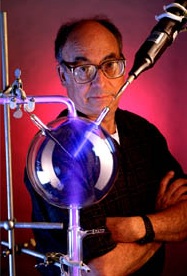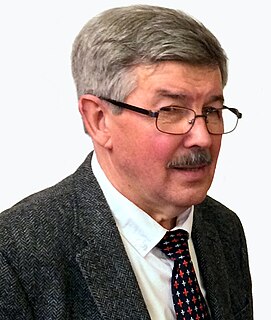
The National Academy of Sciences (NAS) is a United States nonprofit, non-governmental organization. NAS is part of the National Academies of Sciences, Engineering, and Medicine, along with the National Academy of Engineering (NAE) and the National Academy of Medicine (NAM).

Stanley Lloyd Miller was an American chemist who made landmark experiments in the origin of life by demonstrating that a wide range of vital organic compounds can be synthesized by fairly simple chemical processes from inorganic substances. In 1952 he carried out the Miller–Urey experiment, which showed that complex organic molecules could be synthesised from inorganic precursors. The experiment was widely reported, and provided support for the idea that the chemical evolution of the early Earth had led to the natural synthesis of chemical building blocks of life from inanimate inorganic molecules. He has been described as the "father of prebiotic chemistry".

Charles Doolittle Walcott was an American paleontologist, administrator of the Smithsonian Institution from 1907 to 1927, and geologist. He is famous for his discovery in 1909 of well-preserved fossils, including some of the oldest soft-part imprints, in the Burgess Shale of British Columbia, Canada.
Simon Conway Morris is an English palaeontologist, evolutionary biologist, and astrobiologist known for his study of the fossils of the Burgess Shale and the Cambrian explosion. The results of these discoveries were celebrated in Stephen Jay Gould's 1989 book Wonderful Life. Conway Morris's own book on the subject, The Crucible of Creation (1998), however, is critical of Gould's presentation and interpretation.

W. Ford Doolittle is an evolutionary and molecular biologist. He is a member of the US National Academy of Sciences and a Fellow of the Royal Society of Canada and the Norwegian Academy of Science and Letters. He is also the winner of the 2013 Herzberg Medal of the Natural Sciences and Engineering Research Council of Canada and the 2017 Killam Prize.

Preston Ercelle Cloud, Jr. was an eminent American earth scientist, biogeologist, cosmologist, and paleontologist. He served in the United States Navy, and led several field explorations of the U.S. Geological Survey. In academia, he was a member of the faculty of Harvard University, University of Minnesota, University of California, Los Angeles, and lastly University of California, Santa Barbara. He was best known for his work on the geologic time scale and the origin of life on Earth, and as a pioneering ecologist and environmentalist. He was credited with coining the term "biogeology." His works on the significance of Cambrian fossils in the 1940s led to the development of the concept "Cambrian explosion," for which he coined the phrase "eruptive evolution."
Sallie Watson "Penny" Chisholm is a U.S. biological oceanographer at the Massachusetts Institute of Technology. She is an expert in the ecology and evolution of ocean microbes.
Hans J. Hofmann was a paleontologist, specializing in the study of Precambrian fossils using computer modelling and image analysis to quantify morphologic attributes.

Academician Mikhail Aleksandrovich Fedonkin is an awarding winning paleontologist specializing in documentation of the earliest animals' body fossils, tracks, and trails. He has also described numerous Vendian-aged fossils including Hiemalora, Cephalonega, and Nimbia occlusa.
Elso Sterrenberg Barghoorn was an American paleobotanist, called by his student Andrew Knoll, the present Fisher Professor of Natural History at Harvard, "the father of Pre-Cambrian palaeontology."

Andrew Herbert Knoll is the Fisher Professor of Natural History and a Professor of Earth and Planetary Sciences at Harvard University. Born in West Reading, Pennsylvania in 1951, Andrew Knoll graduated from Lehigh University with a bachelor of arts in 1973 and received his Ph.D. from Harvard University in 1977 for a dissertation entitled "Studies in Archean and Early Proterozoic Paleontology." Knoll taught at Oberlin College for five years before returning to Harvard as a professor in 1982. At Harvard, he serves in the departments of Organismic and Evolutionary Biology and Earth and Planetary Sciences.
Martin Fritz Glaessner AM was a geologist and palaeontologist. Born and educated in Austro-Hungarian Empire, he spent the majority of his life in working for geoscientific institutes in Austria, Russia, Australia, and studying the geology of the South Pacific in Papua New Guinea and Australia. Glaessner also did early work on the classification of the pre-Cambrian lifeforms now known as the Ediacaran biota, which he proposed were the early antecedents of modern lifeforms.
Steven M. Stanley is an American paleontologist and evolutionary biologist at the University of Hawaii at Manoa. He is best known for his empirical research documenting the evolutionary process of punctuated equilibrium in the fossil record.

John P. Grotzinger is the Fletcher Jones Professor of Geology at California Institute of Technology and chair of the Division of Geological and Planetary Sciences. His works primarily focus on chemical and physical interactions between life and the environment. In addition to biogeological studies done on Earth, Grotzinger is also active in research into the geology of Mars and has made contributions to NASA's Mars Exploration Program.
The Mary Clark Thompson Medalis awarded by the U.S. National Academy of Sciences "for most important service to geology and paleontology." Named after Mary Clark Thompson and first awarded in 1921, it was originally presented every three years together with a $15,000 prize.
James William Schopf is an American paleobiologist and professor of earth sciences at the University of California Los Angeles. He is also Director of the Center for the Study of Evolution and the Origin of Life, and a member of the Department of Earth and Space Sciences, the Institute of Geophysics and Planetary Physics, and the Molecular Biology Institute at UCLA. He is most well known for his study of Precambrian prokaryotic life in Australia's Apex chert. Schopf has published extensively in the peer reviewed literature about the origins of life on Earth. He is the first to discover Precambrian microfossils in stromatolitic sediments of Australia (1965), South Africa (1966), Russia (1977), India (1978), and China (1984). He served as NASA's principal investigator of lunar samples during 1969–1974.
The Stanley Miller Medal is an award to be presented by the National Academy of Sciences every five years to promote research and study in the fields of "research on Earth's early development as a planet, including prebiotic chemistry and the origin of life; planetary accretion, differentiation, and tectonics; and early evolution of the atmosphere and oceans".








